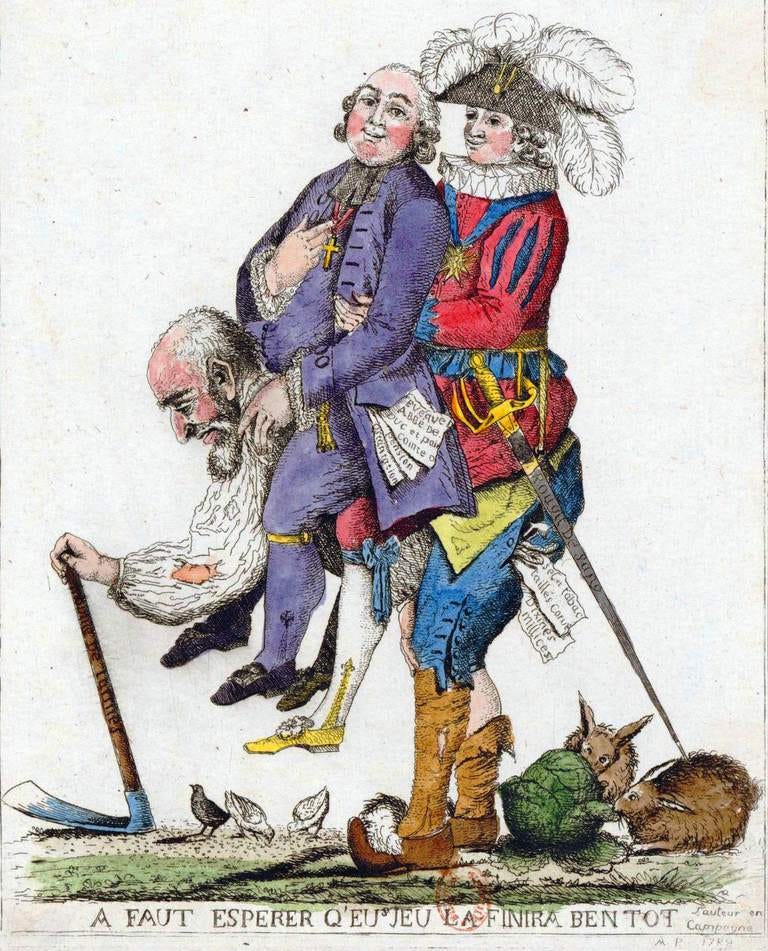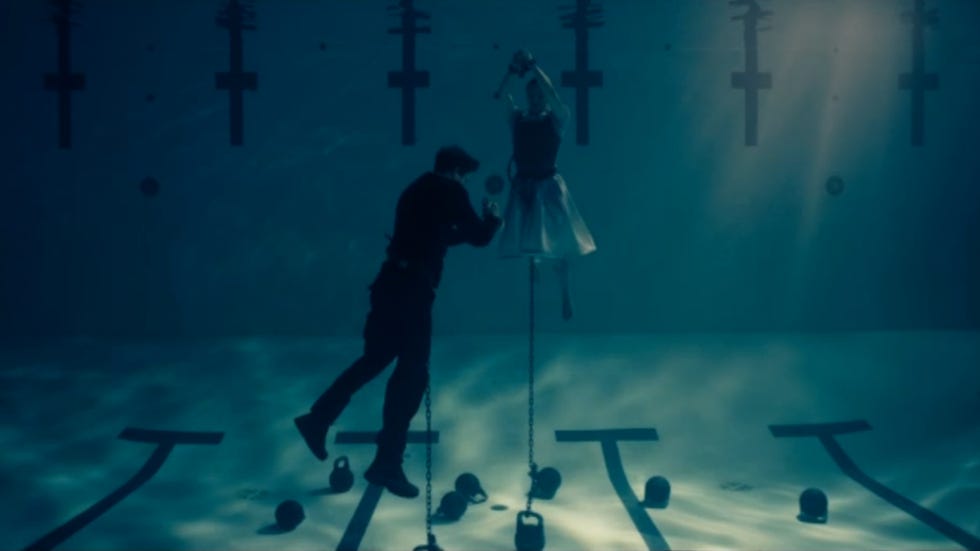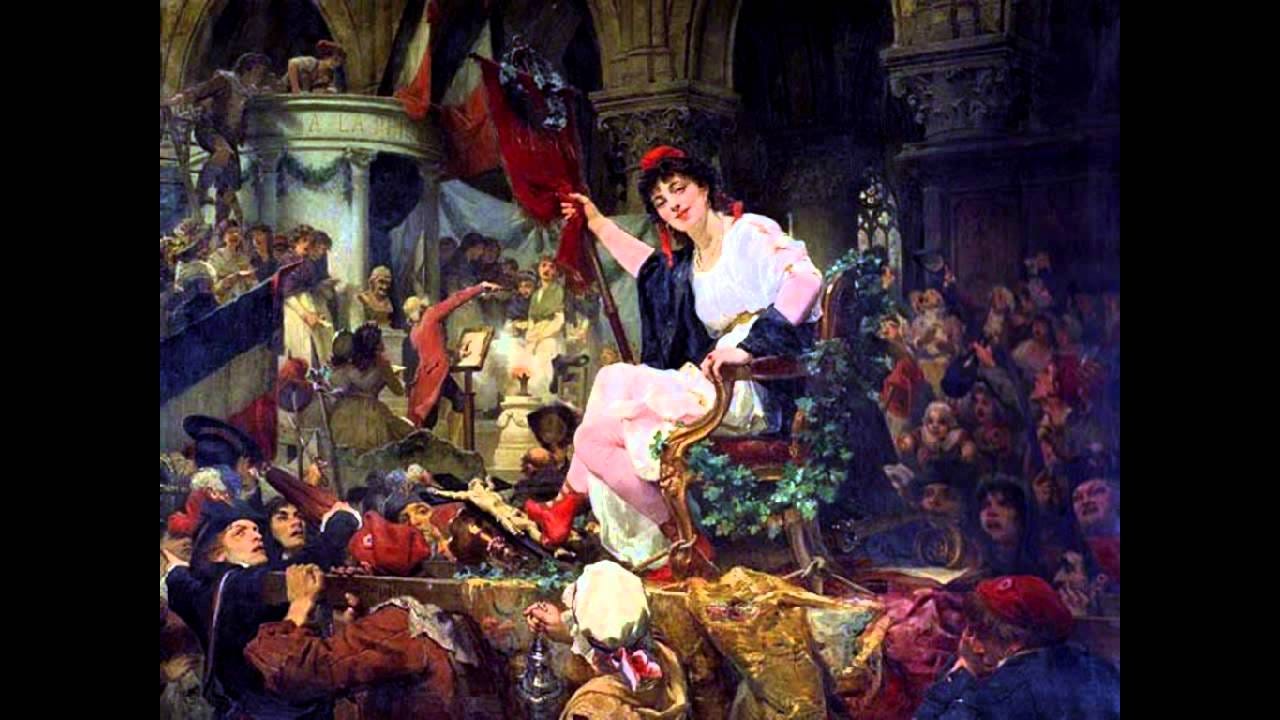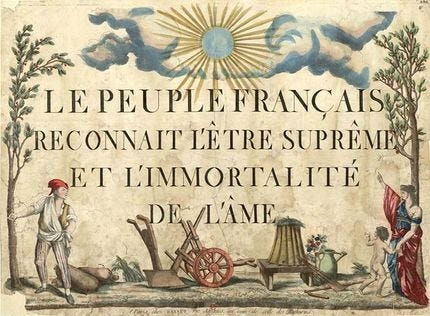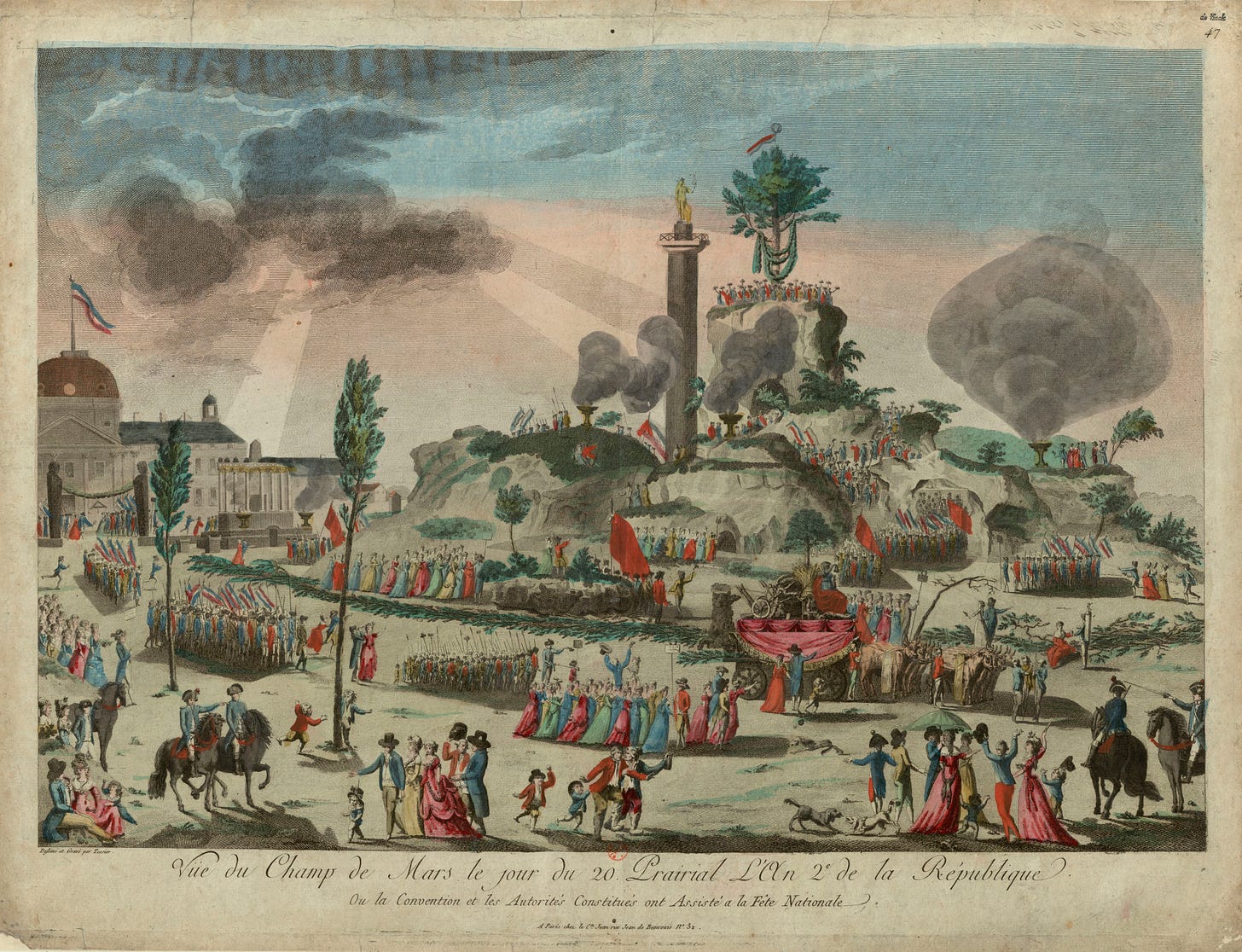The French Revvie Part VII: Dialogues of the Rationalites
The uproar between 1789 and 1799 was in large part a three-pronged religious civil war.
The picture below is a scene from the 1957 Francis Poulenc opera, Dialogues of the Carmelites. Its last scene is one of the most moving in all opera. After the Revolution has repossessed religious property and outlawed monastic orders, a group of Carmelite nuns has been discovered still secretly faithful to their vows, and has been condemned to death. One by one they mount the scaffold, singing the Salve Regina; each walks offstage into darkness, and there is the sound of the guillotine slicing. The voice is silenced. Finally only one singer remains. As she walks towards her death, her friend — who has run away from the group out of fear — emerges from the crowd and follows her to execution, taking up the song. One last slice of the guillotine. Silence.
Even a leathery old hardened case like me must shed a tear.
The opera is based on a real event. It took place on July 17, 1794. Ten days later, Robespierre himself had been killed in the same way, and the Terror was over. As a footnote, let us just remark that the adrenaline-fuelled crowd scenes around mass executions had many of the same features as those around the witch-burnings of a couple of centuries earlier, except that the shoe was on the other foot: the Church was the target, not the accuser.
Mind you, there were reasons for the outburst of anti-clericalism that swept through France before and after 1789. Members of the Church were the First Estate, with the nobility being the Second Estate and everyone else being the Third Estate.
As you can see in both the picture and the chart above, goods (such as land) and financial obligations (such as taxes) were very unevenly distributed. Clergy and Nobility were only 3% of the population, yet they owned a disproportionate amount of land and payed little or no taxes. The Third Estate had to fork over half their income to keep the government running and the other two Estates in silk stockings. They received very little in return for the money they were paying out.
But a large percentage of the French population was devout, especially in some of the provinces that were far from Paris. They resented the expulsion of their priests, the forcing of other priests to swear an oath of loyalty to the State (for which they were then excommunicated by the Pope), the loss of the charitable alms-giving and hospitals once provided by the Church, and the pillaging of their churches and the conversion of them into “Temples of Reason.” Counter-revolutionary movements sprang up, then Royalist Catholic armies, wearing Sacred Heart badges and comprised of emigrés, loyal Catholics, foreign fighters, and so forth. They won quite a few battles at first.
To suppress them, the State instituted a general conscription, and sent prominent Jacobins “on mission” to deal with insurgents. Repressions were brutal, and both military and civilian casualties were high.
Below is a scene from the television series, The Handmaid’s Tale: two young lovers are being drowned in a swimming pool for being disobedient to the State.
One of the rules for both the book and the series is that nothing could go in that did not have a precedent in history. I offer you the mass drownings at Nantes, carried out by Jean-Baptiste Carrier, during which between 1,500 and 4,000 people were put into boats and dumped into the Loire. Whether there were really “Republican marriages” in which a man and a woman were roped together before being sunk is a matter of speculation, but that was the story; it was also the subject of more than one sado-porn painting:
Oh those painters! Anything to get the clothes off! Carrier, below, is particularly villainous-looking; the second-string Revolutionaries are piratical. I like the lightning striking (what?) in the distance. Heaven is not pleased! (Let’s guess: it was not a Republican who painted this.)
Meanwhile, back in Paris, two other factions were locked in mortal combat. Both were Jacobins, from the radical left. They were engaged in the usual Bolshevik-Menshevik contest: Mirror, mirror, on the wall, Who is the most revolutionary of all? The Hébertists were out-and-out atheists: no God at all for them. They put signs over cemeteries that said “Death is an eternal sleep” — so joy-making, though in contrast to hellfire and tortures I suppose it was — and in 1793 they staged a Festival of Reason, with good-looking young women impersonating the “Goddess of Reason,” whatever that might mean. Anyway, they had a good time, including “depravity,” said their detractors. (Reason wears red boots and shows quite a lot of leg. Plato this is not.)
But Robespierre, who wanted a virtuous Republic, was having none of this. There should be some sort of Supreme Being greater than humans, and there ought also to be an Afterlife, because otherwise, you know — depravity. A war of speeches and pamphleteering and mutual denunciation went on between the two factions, with the Hébertistes wanting more and more extreme measures and the Robespierre faction accusing them of bringing the Republic into disrepute. Finally Hébert attempted a physical coup, but the Paris commune did not rise to support him, the coup failed, and off went twenty of the leading Hébertists to the guillotine.
Finally, the road was clear for Robespierre’s new religion. Unimpeded, he got his form of Deism – which included the immortality of the soul– voted in by the National Convention as the nationallike religion of France. (That might be the Goddess of Reason in the right-hand corner above; she is pointing to the Supreme Being, who is round, as such are. She is certainly not your average peasantess. In fact, except for the bare arm and the lack of a veil, she looks like a ripoff of the Virgin Mary and the Christ Child.) In celebration, Robespierre planned a Festival of the Supreme Being, the physical trappings of which were designed by the painter David. It took place on June 8, 1794, and was probably the happiest day of Robespierre’s life.
Processions of this and that, including breast-feeding mothers – a Revolutionary fetish – wound their way up an artificial mountain. (Everyone loves a parade.) The whole thing was intensely staged. At the top, Robespierre — wearing a sky-blue coat — read a laudatory and inspirational speech. Then he came down from the mountain, like Moses, causing one of his fellow deputies to comment, “Look at the bugger; it’s not enough for him to be master, he has to be God.” Uh oh. The label of “tyrant,” which was fatal at that time, was already being affixed to him.
Why am I telling you all this? Because it’s instructive.
It’s very difficult to do away with religion altogether. You may attempt to abolish one kind, as the Revolution did, but then up pops another one — Goddess of Reason or whatever — and then another, Cult of the Supreme Being. If you’re going to have a religion, at least let’s hope it’s one that’s interested in kindness and mutual help, not just chopping people’s heads off and drowning them.
Civil wars are bad, but religious civil wars are worse, because people commit atrocities in the belief that they are being virtuous.
State religions are not consistent with democracy. They aren’t even consistent with religion, spiritually understood. The United States put freedom of worship into the Constitution so there wouldn’t be any attempts to force the United States into a state religion. They didn’t want religious civil wars of the kind that had been plaguing Europe since the Gutenberg printing press had given rise to splinter groups and factions.
There’s a movement at present to force a state religion onto the United States. If I were you I would resist it.
A new book has just come out from Jim Wallis, founder of Sojourners, an evangelical Christian social justice and pro-democracy movement. It warns against the attempt to institute a false form of Christianity that is far from the words of its central figure, Jesus. It holds that some souls are superior to others on the basis of race, and that the superior ones are White; and it commits the heresy of saying that it Knows that this is what God wants. Here is the book:
It’s not just for professing Christians. It’s for those professing a belief in democracy. You can find it here:
https://www.amazon.com/False-White-Gospel-Nationalism-Reclaiming/dp/1250291895
Time to take all this seriously. Because other people are. “Religion” is being weaponized more than at any time since the 17th C. Trust me!
Next: Thermidor! Not a fancy lobster dish!
Keep reading with a 7-day free trial
Subscribe to In the Writing Burrow to keep reading this post and get 7 days of free access to the full post archives.





